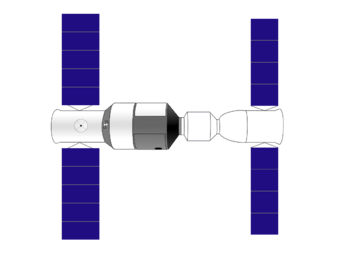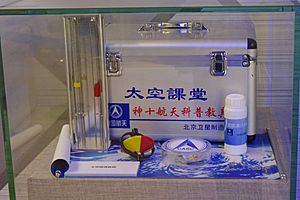Shenzhou 10 facts for kids

Diagram of Shenzhou 10 (right) docked with Tiangong-1 (left)
|
|
| Mission duration | 14 days, 14 hours, 29 minutes |
|---|---|
| Spacecraft properties | |
| Spacecraft type | Shenzhou |
| Manufacturer | CASC |
| Crew | |
| Crew size | 3 |
| Members | Nie Haisheng Zhang Xiaoguang Wang Yaping |
| Start of mission | |
| Launch date | 11 June 2013, 09:38:02 UTC |
| Rocket | Long March 2F |
| Launch site | Jiuquan LA-4/SLS |
| End of mission | |
| Landing date | 26 June 2013, 00:07 UTC |
| Landing site | Inner Mongolia |
| Orbital parameters | |
| Reference system | Geocentric |
| Regime | Low Earth |
| Perigee | 262 kilometres (163 mi) |
| Apogee | 315 kilometres (196 mi) |
| Inclination | 42.7 degrees |
| Period | 90.28 minutes |
| Epoch | 12 June 2013 |
| Docking with Tiangong-1 | |
| Docking date | 13 June 2013, 05:11 UTC |
| Undocking date | 25 June 2013 |
| Time docked | 12 days |
|
Shenzhou program
|
|
Shenzhou 10 (which means 'Divine Vessel 10' in Chinese) was a space mission from China. It launched on June 11, 2013, with people on board. It was China's fifth time sending astronauts into space.
Three astronauts were on board: Nie Haisheng (the commander, who had flown before), Zhang Xiaoguang (who helped connect the spacecraft), and Wang Yaping (the second Chinese woman to go to space). Their spacecraft, Shenzhou 10, connected with China's space lab, Tiangong-1, on June 13. The astronauts then did many science experiments and tests inside. Shenzhou 10 was the second and last mission to visit Tiangong-1. After successfully completing its tasks, Shenzhou 10 returned to Earth on June 26, 2013.
Contents
Getting Ready for Space
Before Shenzhou 10 launched, scientists planned the best time for it to meet with the Tiangong-1 space lab. They wanted to make sure Tiangong-1 was in the right orbit. This careful planning helped set the launch date for Shenzhou 10.
This mission was the fifth time China sent people into space as part of the Shenzhou program. It happened ten years after the very first Shenzhou mission, Shenzhou 5.
News reports shared details about the mission as it got closer. People learned that the crew would include a female astronaut. It was also known that the launch would happen early in the summer of 2013.
The official news agency, Xinhua, confirmed the mission's goals. They also mentioned that Wang Yaping was the only female astronaut training for the flight. Wang Yaping was announced as a crew member in April 2013. The full crew was revealed in June, just before launch. The Shenzhou 10 crew had also trained as backup for the previous mission, Shenzhou 9.
Launch and Connecting in Space
Shenzhou 10 blasted off on June 11, 2013, at 9:38 AM UTC (which was 5:38 PM local time in China). A powerful Long March 2F rocket carried the spacecraft into space. The launch happened from the Jiuquan Satellite Launch Center in Inner Mongolia.
The spacecraft successfully reached low Earth orbit and then separated from the rocket. This mission lasted 15 days, making it China's longest human spaceflight at that time. It was two days longer than the previous record held by Shenzhou 9. China's President, Xi Jinping, was there to see the astronauts off and watch the launch.
The Shenzhou 10 spacecraft connected with the Tiangong-1 space lab on June 13, at 5:11 AM UTC. About three hours later, the astronauts opened the hatch and floated into the space lab.
Returning Home
Shenzhou 10 came back to Earth on June 26, 2013, at 12:07 AM UTC. The entire mission lasted 14 days, 14 hours, and 29 minutes. The spacecraft landed safely in Inner Mongolia.
Mission Goals
Once Shenzhou 10 was connected to Tiangong-1, the three astronauts got to work. They did many experiments related to space medicine, technology, and other science topics.
- Nie Haisheng was the mission commander. He was in charge of making sure the spacecraft connected correctly.
- Zhang Xiaoguang was the pilot. He handled the important tasks of meeting and connecting with the space lab.
- Wang Yaping performed the science experiments. She also gave a special physics lesson to students in China, which was broadcast live on television.
On June 23, Shenzhou 10 undocked (disconnected) from Tiangong-1. Then, the astronauts practiced connecting with the station again, but this time they did it manually (by hand). This was an important test for future missions.
The Crew
| Position | Crew member | |
|---|---|---|
| Commander | Nie Haisheng Second spaceflight |
|
| Operator | Zhang Xiaoguang First spaceflight |
|
| Laboratory Assistant | Wang Yaping First spaceflight |
|
On June 16, 2013, Wang Yaping was one of only two women in space. This day was also the 50th anniversary of Vostok 6, which was the first space flight by a woman, Valentina Tereshkova. The other woman in space that day was Karen Nyberg, who was on the International Space Station.
A Lesson from Space
One of the most famous parts of this mission was the science lesson given by astronaut Wang Yaping from space. On June 20, around 10:00 AM, two physics teachers started the lesson in a classroom in Beijing. A few minutes later, the astronauts appeared live to 60 million Chinese students!
The students watched as Wang Yaping did five cool experiments in the microgravity of space:
- Measuring Mass: She used Newton's second law (F=ma) to measure the mass of Nie Haisheng. He weighed about 74 kg (163 lb).
- Simple Pendulum: The class in Beijing showed a normal pendulum swinging. Then, Wang Yaping showed how a pendulum in space just kept spinning in circles.
- Gyroscope Behavior: Wang Yaping showed two gyroscopes, one spinning and one still. When she gently touched them, the spinning one kept its direction, showing how gyroscopes work in space.
- Surface Tension: She demonstrated how important surface tension is when there's no gravity. She made a film of water inside a ring. When she moved it, the water film bulged but didn't break.
- Water Ball: Wang Yaping showed that water naturally forms a nearly perfect ball in space. She explained that this happens because of surface tension.
See also
 In Spanish: Shenzhou 10 para niños
In Spanish: Shenzhou 10 para niños


